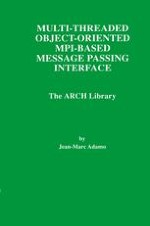1998 | OriginalPaper | Buchkapitel
Synchronous Point-To-Point Communication
verfasst von : Jean-Marc Adamo
Erschienen in: Multi-Threaded Object-Oriented MPI-Based Message Passing Interface
Verlag: Springer US
Enthalten in: Professional Book Archive
Aktivieren Sie unsere intelligente Suche, um passende Fachinhalte oder Patente zu finden.
Wählen Sie Textabschnitte aus um mit Künstlicher Intelligenz passenden Patente zu finden. powered by
Markieren Sie Textabschnitte, um KI-gestützt weitere passende Inhalte zu finden. powered by
In the previous chapter one described two classes aimed at thread creation and concurrent execution. As far as threads are concerned, there is enough material in the Thread class for point-to-point synchronization and communication, which can be based on stop and schedule utilization (see Chapter 2). The same does not apply to the S_Thread class that does not provide these functions. In any case, stop and schedule are too low-level constructs to be really considered as tools for convenient daily use. This chapter focuses on the description of higher-level mechanisms for point-to-point synchronous communication that use specific data objects, called synchronous channels, together with a pair of send and recv functions. ARCH channels are similar to OCCAM’S [OCM 88], although the former have been extended to apply to both intra- and inter-process synchronous communication. Channels also are data structures on their own, from which the user code can read status information. The channel classes are defined as template classes, which allows the C++ compiler to check the type-consistent application of sendlrecv functions. This chapter presents the asynchronous channels and provides an accurate description of deterministic and non-deterministic synchronous communication.
